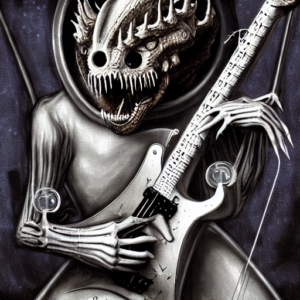Progressive Shred Techniques: Breaking Down the Boundaries of Traditional Shred
In the world of guitar, the term “shred” has long been associated with lightning-fast solos and virtuosic playing. But while traditional shred techniques like sweep picking and two hand tapping have long been a mainstay of the genre, a new movement within the shred community is starting to push the boundaries of what’s possible on the guitar. These progressive shred techniques have changed the shape of shred over the last several years.
The Rise of Progressive Shred
This movement is known as progressive shred, and it’s a style that incorporates a wide range of techniques and influences from other genres. From standard shred techniques such as alternate picking and economy picking to more experimental techniques like hybrid picking and 8 finger tapping, progressive shred is all about breaking down the boundaries of what’s traditionally considered “shred” and taking the guitar to new heights.

The Benefits of Progressive Shred Techniques
So why should you consider incorporating progressive shred techniques into your playing? Here are a few benefits:
- Increased creativity: By breaking away from traditional techniques and exploring new approaches, you’ll open yourself up to a whole world of creative possibilities. This can help you come up with more unique and original solos, and it can also help you stand out in a crowded genre.
- Improved dexterity: Many progressive shred techniques require a high level of precision and control, which can help you improve your overall dexterity and coordination. This can not only make you a better player, but it can also make playing more enjoyable and effortless.
- Expanded musical vocabulary: By incorporating techniques and influences from other genres, you’ll be able to add more depth and variety to your playing. This can help you better express yourself and your musical ideas, and it can also help you connect with a wider audience.
Hybrid Picking
Hybrid picking is a guitar playing technique that combines the use of a pick and the fingers of the picking hand. This technique allows the guitar player to play fast, intricate passages that would be difficult to execute with just a pick or just the fingers.
Hybrid picking can be used to play both lead and rhythm guitar and is popular in a variety of musical genres such as rock, country, and jazz.
In modern progressive shred guitar, a whole new extreme version of hybrid picking as emerged and is changing the face of modern shred.
To execute hybrid picking, the player holds the pick between their thumb and index finger and uses their middle, ring, and sometimes even their pinky finger to pluck the strings. With practice, guitarists can use hybrid picking to play smooth, legato lines and alternate between picking and fingerpicking in the same phrase.

8 finger tapping
8 finger tapping is a guitar playing technique that involves the use of all four fingers on both the picking and fretting hands o play rapid, complex tapping patterns on the fretboard.
This technique is often used in modern progressive shred guitar playing to play fast, technical lines and solos.
To execute 8 finger tapping, the guitarist plays a series of single notes or chords by tapping their fingers on the fretboard, using all eight fingers to create a continuous stream of notes.
This technique requires precise finger control, timing, and coordination, as well as a strong picking hand to keep up with the rapid taps. 8 finger tapping can be used to play a wide range of musical styles, from metal and rock to jazz and fusion, and when used effectively, it can add a unique and impressive element to a guitar player’s playing style.
Extreme Sweep Picking
Sweep picking is a guitar playing technique that involves “sweeping” the strings in a controlled strum. While the picking motion may superficially appear similar to strumming chords, sweep picking is a monophonic technique which means that only one note plays at a time.
This creates a smooth, fluid sound and allows the player to play rapid, complex patterns that would be difficult or even impossible to execute with alternate picking alone. Sweep picking requires precise timing, a steady picking hand, and a lot of practice to master, but when done well, it can add a unique and impressive element to a guitar player’s playing style.
Standard sweep picking patterns are made up of single notes on consecutive strings played with this sweeping motion of the picking hand.
This technique is often used in extreme ways in modern progressive shred guitar to play fast, complex runs and arpeggios. Unlike the traditional use of sweep picking, the extreme sweep picking found in modern progressive shred usually incorporates complex rhythms or long strings of fusion style complex arpeggios.

Getting Started with Progressive Shred Techniques
So how do you get started with progressive shred techniques? Here are a few tips:
- Start slowly: Don’t try to do too much too soon. Begin with simpler techniques and gradually work your way up to more complex ones as you improve. It’s also a good idea to use a metronome to help you focus on accuracy and timing.
- Experiment with different techniques: Don’t be afraid to try new things and see what works for you. This could mean incorporating hybrid picking, 8 finger tapping or extreme sweep picking into your shred solos, or experimenting with different scales and modes.
- Don’t neglect your traditional shred skills: While it’s important to explore new techniques, it’s also important to continue developing your traditional shred skills. Make sure to continue practicing techniques like alternate picking and two hand tapping to maintain a strong foundation in traditional shred.
Shred on!


 patterns over and over again, but this can lead to a lack of creativity and musical diversity in your playing.
patterns over and over again, but this can lead to a lack of creativity and musical diversity in your playing.




 you can, but where’s the fun in that? Sweep picking allows you to explore the full range of the guitar neck and create complex and fluid melodies that might not be possible with other techniques. It’s a way to add depth and emotion to your playing and really make your guitar sing.
you can, but where’s the fun in that? Sweep picking allows you to explore the full range of the guitar neck and create complex and fluid melodies that might not be possible with other techniques. It’s a way to add depth and emotion to your playing and really make your guitar sing.










 in a single picking motion. This allows you to play fast arpeggios and complex chords with ease and fluidity, giving your solos a smooth, cascading sound.
in a single picking motion. This allows you to play fast arpeggios and complex chords with ease and fluidity, giving your solos a smooth, cascading sound. Once you’ve mastered the basics of sweep picking, it’s time to start incorporating it into your playing. Start with simple, two-string arpeggios and work your way up to more complex chords and patterns. As you practice, pay attention to your picking hand and make sure that you’re using a smooth, fluid motion.
Once you’ve mastered the basics of sweep picking, it’s time to start incorporating it into your playing. Start with simple, two-string arpeggios and work your way up to more complex chords and patterns. As you practice, pay attention to your picking hand and make sure that you’re using a smooth, fluid motion.